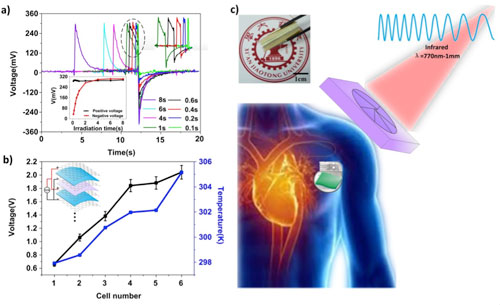| Posted: Nov 06, 2015 | |
Light-driven bioelectronic implants without batteries |
|
| (Nanowerk Spotlight) Benefitting from the miniaturization enabled by nanotechnologies, bioelectronics is a growing research field that is concerned with the convergence of biology and electronics: the application of biological materials and processes in electronics; and the use of electronic devices in living systems. | |
| Among the latter, implantable bioelectronic devices wirelessly powered by different stimuli provide electrical impulses to precisely modulate the body's neural circuits – although wireless powering and remote manipulation still remain a major challenge for the practical use of these devices, which include retinal and cochlear implants; deep brain stimulators for epilepsy and Parkinson's disease; pacemakers; and brain-machine interfaces. | |
| Adding to the options for wirelessly powering implants from outside the body, researchers in China are proposing a light-driven powering device using near infrared rays (nIR). Flashing light impulses, which are absorbed by the device, induce temperature fluctuation, thus generating voltage/current pulses which can be used for charging a battery or biological stimulations. | |
| "Compared to the wireless power transport by electromagnetic coupling, near-infrared light with a wavelength of 760-1500 nm – known for its heating and medical physical therapy effects – provides an alternative wireless power that can penetrate into human tissue up to a depth of 4-10 cm," Prof. Hongzhong Liu and Dr. Weitao Jiang, from the State Key Laboratory for Manufacturing Systems Engineering at Xi'an Jiaotong University, explain to Nanowerk. | |
| The team reported their findings in the October 29, 2015 online edition of Advanced Functional Materials ("Flexible battery-less bioelectronic implants: wireless powering and manipulation by near infrared light"). | |
| Inspired by the photothermal effect of nIR in biomedical applications, Liu's team fabricated a remotely/wirelessly controlled battery-less implantable device driven by nIR. | |
 |
|
| a) Modulation of voltage pulse for graphene/PVDF/graphene by irradiation time when the non-irradiation time is fixed. b) Laminated cell number dependence of the open-circuit voltage output and the temperature on the top. c) Scheme of a compact, flexible battery-less device for wireless powering and nerve stimulators which can be remotely manipulated by nIR irradiation and Photograph of laminated sample (top left corner). (Image: State Key Laboratory for Manufacturing Systems Engineering, Xi'an Jiaotong University) (click on image to enlarge) | |
| "What has motivated us to add to the existing devices for wireless powering systems is that a miniature power supply without the need for a battery is greatly desired for bioelectronics," says Jiang. "Besides, for bioelectronic intervention in body, device flexibility and the controllability of stimuli are also the greatest challenges." | |
| "Our flexible and compact device can generate electrical pulses with controllable amplitude and width when remotely irradiated by nIR," notes Liu. "Not only can it supply power to implantable bioelectronics, but it also provides adjustable electrical pulses for nerve stimulation." | |
| "In nerve stimulation, it is important to modulate the impulses that flow through the stimulated nerves," he elaborates. "The stimulus waveforms –i.e., amplitude; pulse width; monophasic versus biphasic; and the delay between the two phases of the biphasic pulse – provide the greatest excitability differences for different nerve fibers." | |
| The scientists point out that, in contrast to wireless powering systems driven by electromagnetic coupling, nIR-driven systems can not only realize far-field energy transfer but also be fabricated as a metal-free system; which is a great advantage in in vivo applications. | |
| This wireless powering system combines PVDF – a specialty polymer in the fluoropolymer family – as active pyroelectric material with graphene as the electrode material. | |
| "PVDF exhibits lightweight, mechanical flexibility and biocompatibility, which are particularly interesting attributes for wearable or implantable devices," says Jiang. "In addition, the strong infrared absorption of PVDF makes it highly suitable for nIR-driven wireless powering system." | |
| Due to its excellent electrical and thermal conductivity, high surface area, and high flexibility, graphene has attracted much attention in recent years. While graphene possesses low absorption inherently in the infrared, it exhibits a transparency of 97.7% in visible wavelengths and even higher transparency in the infrared. | |
| Each cell in the team's implantable power device is composed of a laminated graphene-PVDF-graphene sandwich, combining the high transparency of graphene and the strong infrared absorption of PVDF thin-film. This serves to enhance its electric properties while reducing the device temperature to avoid damage to intervening and surrounding normal tissue. | |
| To demonstrate the practical use of their device, the researchers implanted their power generation device as a stimulator for real-time functional electrical stimulation of a sciatic nerve of a frog and a rat heart, by a remote control by nIR irradiation. | |
| Apart from pacemakers and nerve stimulation, direct electrical activation has been widely used to recover the function of neurons. Going forward, the team will explore their device's application in the area of neural recovery by remote control in vitro and integrate some functional devices, i.e., compact camera, and stimuli tips, on the developed internal stimuli systems. | |
 By
Michael
Berger
– Michael is author of three books by the Royal Society of Chemistry:
Nano-Society: Pushing the Boundaries of Technology,
Nanotechnology: The Future is Tiny, and
Nanoengineering: The Skills and Tools Making Technology Invisible
Copyright ©
Nanowerk LLC
By
Michael
Berger
– Michael is author of three books by the Royal Society of Chemistry:
Nano-Society: Pushing the Boundaries of Technology,
Nanotechnology: The Future is Tiny, and
Nanoengineering: The Skills and Tools Making Technology Invisible
Copyright ©
Nanowerk LLC
|
|
|
Become a Spotlight guest author! Join our large and growing group of guest contributors. Have you just published a scientific paper or have other exciting developments to share with the nanotechnology community? Here is how to publish on nanowerk.com. |
|
